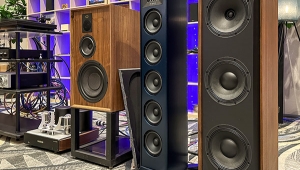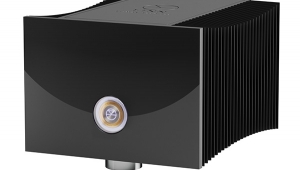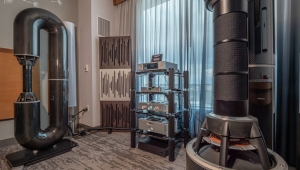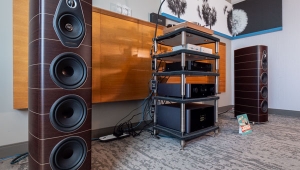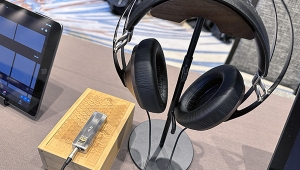| Columns Retired Columns & Blogs |
Westone 3 in-ear headphones
Designed to be used onstage by musicians monitoring their sound and mix, in-ear monitors (IEMs) such as the new Westone 3 are great in situations where you want to hear nothing but the music. They're small and portable, and their high efficiency and easy impedance load mean they work well with portable players. IEMs are better than electronic-feedback, noise-reducing, closed circumaural phones at blocking out airplane engine noise and annoying neighbors who want to chat. They're also more compact, sound better, and don't require batteries.

I've owned five IEMs, beginning with Shure's E3c, which John Atkinson reviewed in the May 2004 Stereophile. I've put many hours on my IEMs, but until I began using the Westone 3, I never took them seriously as perfectionist audio components.
As Westone writes in its press releases, the company is "the world's largest supplier of custom and universal-fit earpieces, specialized equipment, and accessories for hearing care professionals." Westone also has a major presence in pro audio, offering several models of IEMs for stage use. But they're not well known in consumer-audio circles, except as a provider of custom earmolds; if you use custom earmolds with your universal-fit IEMs, there's a good chance they're Westones.
Three-driver IEMs have been around for a few years, but true three-ways are new on the consumer-audio scene. Doug Leavy, Media/Communications Specialist for Westone Music Products, says that the 3, introduced around Thanksgiving last year, is "the first true three-way universal-fit earphone for personal listening." The stated frequency range of 18Hz–18kHz is the same for both the 3 and Westone's similar pro models, but the sensitivity and impedance specs differ. Leavy says those differences are incidental, consequences of the different voicings of the consumer and pro models.
When I asked about those different voicings—Westone released its first pro three-way IEM in 2004—Leavy quoted from some marketing copy that compared the Westone 3 with their UM3X, a recent-vintage, universal-fit, three-way model intended for the pro market. It described the midrange of the 3 as "detailed," and the midrange of the UM3X as "smooth"; the 3's highs are "crisp," while those of the UM3X are "detailed and clean." Clearly, Westone isn't interested in revealing its recipe for what it considers to be consumer-friendly sound.
In addition to the IEMs themselves, the package includes a removable inline volume control, a lovely little leather pouch, an earwax lasso for cleaning the sound tubes, and 10 different pairs of tips—the part of a universal-fit IEM that seals in your ear canal. The selection includes soft (gray) and less-soft (clear) rubber tips in various sizes, one pair of triple-flange tips that looked like a good idea but didn't seal my ears well, and the tapered memory-foam tips that I preferred, in three sizes. Also included is a ¼" adapter so you can use the 3 with your home setup, though the cable is pretty short for that. The cable is flexible and braided with a nice, heavy feel—"pure copper wire with a tinsel wrap and plastic shell," Leavy says.
Westone's "street price" for the 3 is $399; I was able to find a pair online for $30 less. That puts it at the top of Westone's universal-fit line, but the company offers custom-fit IEMs up to $850. Compared to IEMs from competing manufacturers, the 3 is moderately priced: well above the ca-$100 entry level but far below the $1100 Ultimate Ears UE11 Pro Wes Phillips reviewed in May 2008.
Use
The Westone 3's sensitivity was noticeably—and usefully—lower than most IEMs, permitting the use of a wider range of your player's volume control and making it less likely that you'll blast your eardrums by turning on the music with the volume set too high—a very real hazard with IEMs.
The best way to use a universal-fit IEM is with the earmolds custom-fitted by an audiologist. I've owned a pair of Westone UM56 earmolds for years, using them with Shure's models E3c, E4, and SE310. Unfortunately, my Westone earmolds didn't work well with the Westone 3; apparently, they've stretched. Leavy says my earmolds are made of vinyl; the company also offers a version in silicone, which Leavy says doesn't stretch. I did most of my listening with the medium-sized foam tips.
The 3s inserted, their sound was pristine and spacious, with very good separation between instruments, plenty of air, well-placed in-head images, and an in-head soundstage that was bigger than my head—an odd sensation. The 3s lacked that artificial crispness that characterizes the sound of my older, less-expensive Shures—a good thing.
The 3s had a richer mix than any other IEMs I've tried. Their sound was full-bodied, palpable, and solid, with the kind of weight you might expect from a top-end circumaural—from Sennheiser, say. Overall, I still prefer my Sennheiser HD650s when listening to headphones at home, but the Westone 3s pushed into audiophile territory—no small accomplishment for a $399 component that seals out airplane noise and weighs less than many phono cartridges (15gm, including cord and foam tips).
But there was one aspect of the Westone 3's sound that kept it from pushing very far into audiophile territory. In my ear canals, and regardless of which tips I tried—including my custom earmolds—the 3 produced a substantial midbass hump. This extra bass set up a mild resonance with some recordings, obscuring some of the music. I associate this kind of voicing with products aimed at pop-music fans, but it was with pop music that the 3 fell short; small-group jazz and chamber music sounded great, the bass and cello lifted up in the mix, sounding rich and creamy. Orchestral music and opera were spacious, with a solid foundation. But on music with prominent, repetitive electric bass—as in several tracks on Los Lobos' The Town and the City (CD, Mammoth/Hollywood 2061 62661-2), it was overwhelming. Your mileage may vary.
Pro vs Consumer Sound
Westone isn't saying, but it's possible the 3 was voiced with a midbass emphasis to win acceptance in the mass market—and maybe that's the difference between "pro" and "consumer" voicing. Some of the more thoughtful consumer reviews on the headphone-enthusiast website www.head-fi.org indicate that the UM3X, Westone's closest pro-model equivalent, offers a more natural presentation than the 3. (For the record, I consulted Head-Fi only after drawing my own conclusions.) Intrigued, I asked Leavy to send me a sample of the UM3X, but he refused: "We're not marketing the UM3X to the consumer market currently," he wrote in an e-mail. Still, it's easy to find the UM3X online, at pro-audio and headphone-specialty stores—and its $20 cheaper than the Westone 3.
I'm intrigued by the possibility that Westone's pro line is voiced to be more accurate than the 3, but not quite intrigued enough to shell out $379 plus shipping. Conceivably, the UM3X shares the 3's considerable virtues while avoiding its single vice. That's a possibility that audiophiles interested in IEMs costing about $400 should consider. Still, at $399 retail, the Westone 3 is an excellent value, especially for those who like plenty of bass.
- Log in or register to post comments
















